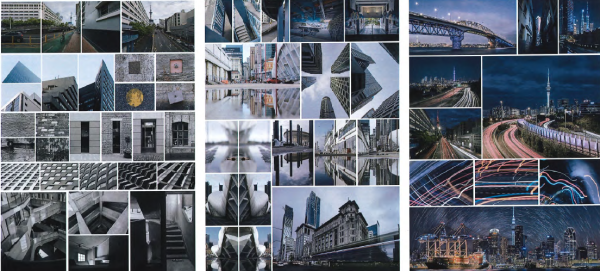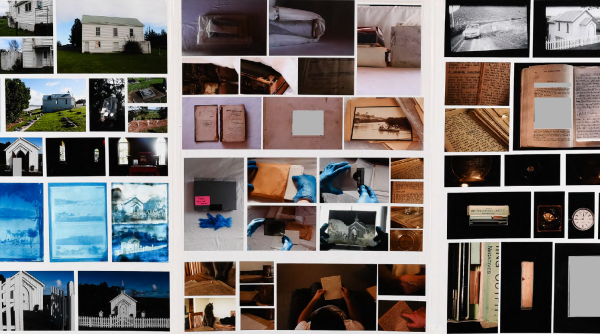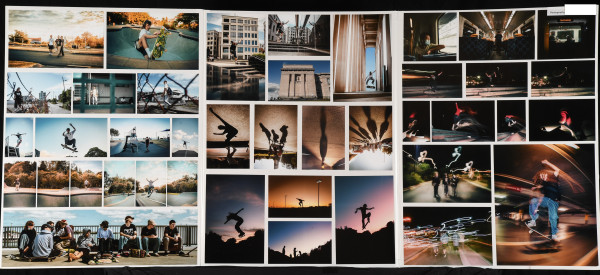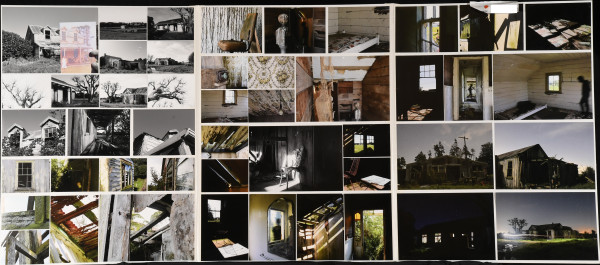2024 Scholarship
This Scholarship submission establishes the concept of the city and its moving nature through time and space. Coming from Shanghai and arriving in New Zealand, the candidate has a strong familiarity with cities and makes connections through their research to colonial history. Referencing ideas of the city to portray beauty that is often overlooked and
neglected, the candidate connects with research to investigate questions such as “is change always a good thing?” and “is architecture photography an art form?” Answers are presented throughout the photographic enquiry using different camera positions and creating photographs that demonstrate the ability to visually articulate buildings, cityscapes, and spaces.
The portfolio has a sense of “unrealising” and forming confusion for the viewer. This strategy employs a point of curiosity for the viewer as the candidate links this idea to M.C. Escher who assembles the impossibilities of space and time. The intention of the proposition positions an interest around the notion of cities and motorways, spaghetti junction, the busyness in a city, surfaces, and decay using the macro versus wide-angle lens. In the workbook, the candidate explains their process in curation of imagery by explaining conventions and references to established practice. An example is the images on Panel 1 that explore decay and deterioration and shift towards abstract surfaces of architecture.
There is a consistent level of analysis and insight to the local cityscape that has enabled the candidate to sustain an in-depth investigation into the natural world and the human-made infrastructure. The workbook contains work from behind the scenes that supports the sequences on the portfolio and forms a parallel commentary about the portfolio work, reviewing decisions about image-making, editing, and sequencing formations. The candidate presents a high degree of technical fluency on the portfolio with further work in the workbook offering experimentation and testing of conventions. There is breadth of engagement, skill in specific editing, and creative thinking within the proposition.
The handling of colour, composition, and lighting of different spaces within the city is sophisticated. The candidate does not rely on trying to create symmetry post-production but rather looks for it in the camera first. Tessellations move beyond the flips as they reference established practice but find purpose to change and own decisions made through research and investment in the project. Light is explored in depth with the move into changing shutter-speed settings to capture light trails within the city to portray the rotation of the Earth and its relativity to the stars. The juxtaposition of star trails balances the exploration of the natural world (star trails) with the human-made structures; the stars light up the city. The portfolio and workbook submission are driven by a photographer that is interested in the art of “looking”.

Download 2024 Scholarship Photography workbook [PDF, 2.9 MB]
On this page
2023 Scholarship
This Scholarship Photography submission focuses on sites of significance for the candidate and her whānau, setting the scene for their family migration story. Their investigation into this family history began at primary school (revisited in 2017, 2020, 2023). Utilising this familial search as a beginning point for a photographic enquiry provided many inroads to the nature of the unfolding image-making.
Seeking out stories and spending time in the town’s chapel, ‘imagining’ these spaces and places where their grandparents once sat, was a pivotal move in developing a connected relationship with the past. The workbook effectively documents the journey taken in honouring the family story through a mix of the candidate’s own conversations with family, recording and telling (written text and old photographs), and thereby establishing a modus operandi for seeking out new ways of seeing whakapapa in the context of their creative discovery process.
In conjunction with their pursuit to know more, the candidate started asking questions about aesthetics and collections. They understand the productive tension between the aesthetics of a handwritten mark, the fade of a well-worn page and the significance of holding an object once held by their ancestors. We know this via their own photographs on the folio and the accounts in the workbook. These were productive prompts for reflecting on family ephemera/printed matter, old photographs and artefacts found or gifted and how these elements/subject matter could be used to stretch out the imagined content across time. Due to the lived experience component of the enquiry, the project remained active and inquiring throughout. The candidate’s Nana was able to share various treasured objects, such as the family bible (containing a hand-drawn face) and two silver/gold pocket watches, which became the central subject matter for later photographs.
Various photography practices are employed; cyanotype, pinhole and darkroom (including stencils and glass negatives) position the work across and in time. Experimentation with non-digital processes conceptually supports their interest in looking into the past, such as using the pinhole camera to take a contemporary family portrait akin to the qualities of the historical family photograph and working with family-owned film slides and glass plate negatives. Incorporating these found images/processes into their own work trajectory created a rich layer to the work that both honours and makes the past present.
Links to artists’ work like Robin Morrison and Robert Frank inform processes and aesthetic decision-making. The candidate was analytical and thoughtful in how they engaged in their artmaking, in parallel with their ongoing experience of learning and knowing more through each iterative phase and artwork made. The folio work evidences an authentic journey through an articulately composed and well-executed body of practice.

Download 2023's Scholarship Photography exemplar [PDF, 17 MB]
2022 Outstanding Scholarship
This Outstanding Scholarship submission embraces youth culture, focusing on the social life of skateboarding in urban environments. There is good 'seeing' in the work; multiple photography shoots were taken when the candidate was out skating with friends. The candidate is interested in composition and taking photos that capture skateboarding culture. They want their images to appeal to the audience and spend time considering how they can photograph the subject accordingly.
The photographic approach employed is highly experimental in the technical management of the camera; they work with and against conventions. Technical considerations are conceptually crucial to how each image is conceived, including technology (fish lens, tripod, ISO, lightroom) and devices of inverting, silhouette, and reflection. They are analytical of their intent behind the steps/ideas for each image.
Every composition is purposeful and constructed either pre- or post-production through critical decision-making and high technical facility. For example, they deliberately under-expose the photo to maintain quality, and then edit the image with consideration of colour and time of day to communicate mood. Throughout the work, they successfully merge in-camera documentation practice with staged portraiture.
The entire project is informed via clear investigations of practice, research, and continuous practice/testing. They repeatedly make very considered pictorial shifts using camera/photo devices and conventions, such as framing, awareness of light, reflection, movement, colour, shape, and silhouette. The images produced are seductive; they capture the beauty of movement and figure/urban setting symmetries. At times, they isolate the performing subject against the sky, framed by concrete structures and architecture to refocus the subjectivity of the image.
The workbook documents their reflections on the practice, most significantly, the composition and intention of their photographs. It also documents other works, edited out of the portfolio but still successful. Their familiarity with the subject matter is very informative. It helps them to know what is possible with the images they take. They use colour, style, and editing tools to 'process' photographic output, which is researched and well-executed. The comprehensive research methodology has enabled the student to understand why they work the way they do.
They invest time in picture-making: reflecting and selecting, then returning to picture-making in a cyclical practice of inquiry, which seems apt in the context of a sport that requires repetition, skill, and technique (practice). Through a purposeful and critical selection of artists' practice/films and their own constant practising, the candidate found a good balance of research between contextual and formal conceptual concerns, and the technical requirements needed to achieve particular results.
This submission is a celebration of skateboarding, friendships, and skills through highly-competent compositional understanding of the camera, intelligent and clever use of leading lines, framing devices, angle, and viewpoint shifts.

Download 2022 Outstanding Scholarship Photography workbook pages [PDF, 23 MB]
2022 Scholarship
This Scholarship submission focuses on the beauty of two derelict, abandoned houses explored through concepts of time, neglect, preservation, and care. The house that set up the inquiry sits on the road the candidate and her family regularly drive. The second house is an early settler-colonial house in Rahotu. Both farm properties and houses act as signifiers of their continual transition and decay over time, sparking the candidate’s interest and imagination about their current and past lives.
The initial connection began as passers-by and a curiosity and desire to learn about their spirit. Granted permission to access the properties, the candidate set about exploring and identifying the type of relationship they wanted to establish with these domestic spaces. Working with a method of encounter and response versus pre-planned photo shoots, the inquiry is, in one sense, an account of becoming familiar, of moving from apprehension to knowing.
The student stated they first thought about what/who was no longer there (death). But after getting to know the site and feeling a sense of mutual comfort between the houses and themselves, they felt “a strong presence of life in the home.” Visiting often and taking frequent photoshoots concretised the personal connection and embedded a robust photographic understanding.
The candidate clearly understands how composition can reveal presence/s and natural symmetries through movements of light (day/night, interior/exterior), positive-negative space, perspective, scale, and macro/micro relations. An astute observation method was applied to the subject and sites based on the candidate’s interest and affection towards these derelict homes that once housed farming families. Appropriate and critically relevant artistic references and analysis in the workbook inform all the work produced.
The workbook also outlines the challenges of capturing their seeing, specifically in the dark spaces of derelict properties without power and night shoots. In becoming close to the site and familiar with the qualities that lent themselves to photographic conventions and ideas, the candidate developed a nuanced approach and inventive strategies for working with natural light (and darkness) and composition created by the house architecture, spatial structures, and window/door frames.
Methods include photographing at different times of day using natural light filters, improvising light (presence) with a phone light inside the house at night to photograph an exterior view. The student’s relationship to their chosen subject, the two houses, and their histories were critical to this inquiry. Through thorough research and time spent on site, they established a reflective kinship considerate of those that had occupied the houses.
In the workbook, they speak of change (physical and social) that had occurred over time, the sale of the land and house, and endings. There is a heartfelt quality to how the photographs capture the beauty and effects of time on these houses; the images emanate a sympathetic aesthetic that communicates the candidate’s investment and commitment to their subject.

Download 2022 Scholarship Photography workbook pages [PDF, 23 MB]

